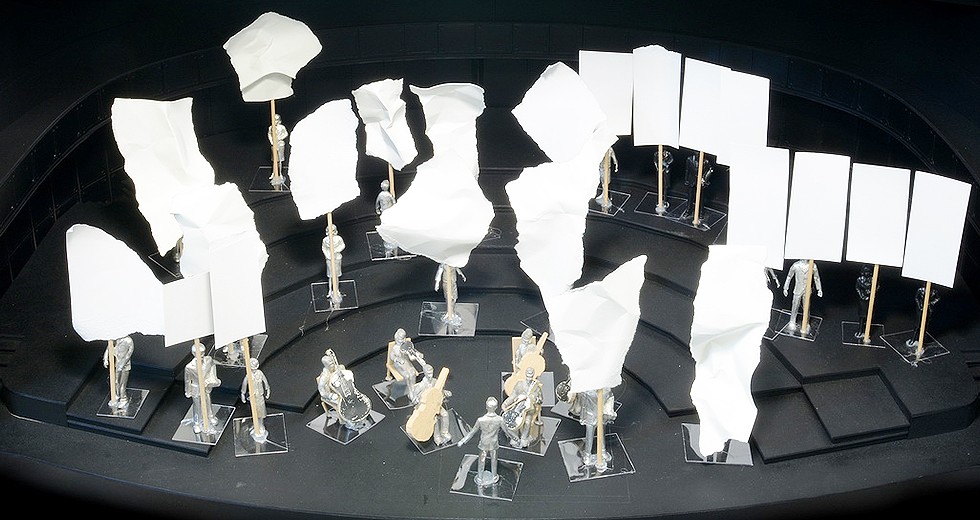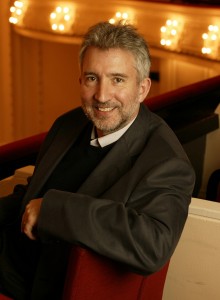
“A Pierre Dream: A Portrait of Pierre Boulez,” a world-premiere Beyond the Score production, salutes the life and work of Pierre Boulez, CSO Helen Regenstein conductor emeritus, who turns 90 in March. World-renowned architect Frank Gehry has designed unique stage elements for this production, which honors the revolutionary composer, conductor and curator by introducing audiences to his imagination and influences. “A Pierre Dream” will be presented Nov. 14 and Nov. 16 at Symphony Center.
Here the creative forces behind the project discuss “A Pierre Dream”:
MARTHA GILMER, EXECUTIVE PRODUCER OF BEYOND THE SCORE
On Sept. 17, 2014, Frank Gehry traveled to the Logan Center at the University of Chicago where Gerard McBurney, creative director of Beyond the Score, and projection designer Mike Tutaj were working with students and faculty on a workshop previewing the upcoming Beyond the Score, focused on Pierre Boulez and tentatively titled “Provisionally Definitive.” This was just six months after conductor Esa-Pekka Salonen first approached Gehry to make the connection on behalf of those of us involved in the Boulez Beyond the Score project to inquire whether he would be interested in designing the set pieces or projection surfaces that would form a critical element of the Boulez BTS. Gehry agreed in principle and met with Gerard McBurney and Cameron Arens [of the CSO artistic department staff ] in Los Angeles at his studio. What came of that initial meeting was a preliminary sketch, followed shortly thereafter by a video of the proposed screens animated to show just how they could be used in Gehry’s concept.
What Gehry saw in Chicago, however, was beyond anything he had imagined. “They have taken it to the moon,” he wrote Esa-Pekka Salonen. When I arrived half-way through the demonstration, Gehry could say only that he had no idea that this project was as complex, as exciting and as grand as what he had just witnessed. Needless to say, he was ecstatic and all of us were thrilled with his excitement.
In the conversation that followed, Gehry talked about his own aesthetic sensibility: his attachment for the very same creative elements, namely bunraku puppetry and the Japanese Imperial Court music of gagaku ensemble, which are such an influence in Boulez’s works, most notably, Le marteau sans maître, Pli selon pli and many others.
Gehry has designed a number (12 in total) of movable surfaces that are to be operated by actors in and around the 18 musicians who are featured in the Boulez BTS. They are in fact reflective of the bunraku style of puppetry where the operators are in full view of the audience as they interact with their subject.
After Gehry’s visit the very next day, six of the moveable surfaces arrived, and the students began unwrapping, assembling and starting to work with them to see how they could function. Over two days through the interactive work of the University of Chicago students, and through the guidance of Mike Tutaj and Gerard McBurney, what emerged was an initial choreography that matched McBurney’s original five-act concept of the work, which takes the audience backward in time from Boulez’s late works, to his earliest composition, and his time in Paris as a student just after World War II.
The images that will be a part of this choreography are historical images of Boulez from his days working as composer-conductor as part of Jean-Louis Barrault’s theater company through his days conducting the BBC Symphony London in performances and studio recordings, all the way to live footage taken of Boulez in his home in Baden-Baden in October 2013.
As we look forward to marking the 90th birthday of Pierre Boulez, whose relationship with the Chicago Symphony Orchestra was one of the most significant relationships in his professional life, it is a stirring tribute that this Beyond the Score, the first of a living composer, be shared by other organizations and colleagues around the world. Early partners include the Ojai Music Festival, whose director, Tom Morris, is a close friend of Boulez and who led the Cleveland Orchestra for many years with Boulez as a pre-eminent guest, and the Cal Performances in Berkeley, Calif., where Matias Tarnopolsky, who worked closely with Boulez in Chicago, is executive and artistic director. The Holland Festival will give the first European performance in June 2015 and a New York performance featuring members of the New York Philharmonic will be conducted by Esa-Pekka Salonen in 2017. Other collaborations are in discussion.
GERARD McBURNEY, CREATIVE DIRECTOR OF BEYOND THE SCORE
Martha Gilmer’s invitation to create a musical and theatrical work about Pierre Boulez came both as a logical development of the Beyond the Score project and as an exhilarating challenge.
It was a logical development, because Pierre Boulez was an essential inspirer and begetter of BTS from its very invention, now — amazingly — a whole decade ago. He wrote and delivered our headline introduction, supported Martha Gilmer (and later also myself) with critical advice in all of the many conversations that moved the idea forward, and he then conducted and entered into every possible aspect of the early BTS we created on Bartók’s The Miraculous Mandarin. It was precisely his involvement that persuaded many other distinguished conductors to offer to join the project. He afterward attended performances of BTS conducted by his colleagues, including one on Beethoven’s Fifth Symphony, where he offered fascinating and unexpected support to all the performers and enriched us with his own insights into the music. Later, led by him, we created one of the most ground-breaking of all our shows, BTS Pierrot lunaire. For that he attended all rehearsals, offering wise advice and friendship not only to the musicians, but to the actors and the lighting and projections team.
For all these reasons, and also because of Pierre Boulez’s long association with the Chicago Symphony Orchestra, it seemed to me a wonderful idea of Martha Gilmer’s to make a full-length show about Boulez himself, as a homage to this great composer-conductor-animateur and as what he himself might have called “a little love letter” from all of us in Chicago to him.
At the same time, such a show immediately throws down a gauntlet: how to make a theatrical experience out of the ornate and sometimes downright elusive music of this great master of post-war modernism? How to bring an audience close to a composer whom many people might think that they do not understand?
Our solution begins with Martha Gilmer’s second idea: to invite Frank Gehry to create the projection surfaces for Mike Tutaj’s beautiful images, drawn from 70 years of film and photography. Within this amazing set and visual world, we have set out to create a dream-like drama — Frank Gehry himself named it “A Pierre Dream” — which will take the audience on an imaginative journey into Boulez’s mind and his sense of fantasy. This projection avoids documentary — Pierre Boulez is no lover of the traditional documentary approach and famously dislikes biography. The projections, in a poetic way, seek to place this artist in the context of his time, and more importantly, of his complex and sometimes paradoxical passions for the pioneering masters of modern art, for figures as different, for example, as the poet Stéphane Mallarmé, the painter Paul Cézanne and the young Igor Stravinsky.
Throughout the show, we see and hear Pierre Boulez at just about every point in his professional life, from the 1940s through to now. We experience some of the ways in which his outlook and his imagination have transformed themselves, sometimes startlingly over 70 years, but we also see that at the same time, his artistic vision has remained throughout pure and true to ideals formed very early in his life.
Above all, this Beyond the Score takes us on a fairground ride through some of Boulez’s most liquid, glittering and beautiful music, from works written at the age of 20 to others completed less than 10 years ago.
Our idea was to create “A Pierre Dream,” which will leave the audience startled and refreshed by Boulez’s music and eager to listen to it — and to respond to it — in ways that they might never have before thought possible.
MIKE TUTAJ, PROJECTIONIST
Creating theatrical expression of Pierre Boulez that reflects not just his music but also the man himself, requires a deep understanding of this unconventional artist. We are fortunate to have such a wealth of material and direct interaction with Mr. Boulez that allows our creative team to present a portrait of this characteristically mystifying man in such human terms.
What excites me so much about this presentation in the Beyond the Score series (this production marks my fifth collaboration with Gerard McBurney and the Chicago Symphony Orchestra) is how the very staging of the piece with Frank Gehry’s rich design concept allows us to fragment and rearrange (and indeed “play with”) the visual storytelling in a way that both directly and subconsciously recalls the music of Pierre Boulez in a visual analogue. It offers us an opportunity to offer a unique staging for this series and marks a wholesale reimagining of what can be achieved theatrically in the performance space, which I’m certain will be engaging and surprising to our audience.
This production will employ 12 discrete and moveable banners that will be manipulated by six puppeteer actors. The actors will interact with the banners to create a variety of shapes and surfaces upon which we can project related imagery. It allows us to move the images to different parts of the stage, putting the focus on different instruments and directing the eyes of the audience to take in a curated perspective of the performance. The diversity of stage pictures we create helps define the mood and further inform the audience to subtleties in the music of Pierre Boulez.
Images we expect to see on the screens include still and moving images of Pierre Boulez spanning over six decades. Serving not only as narrative content, the projected images support the actors and musicians on stage, to relinquish focus to the other performers as needed to tell the story. This conversation between the media, the scenic design and the performers is critical to absorbing our audience in the theatrical journey.
TOP: An early model of “A Pierre Dream,” designed by Frank Gehry Partners. | Courtesy of Frank Gehry Partners


